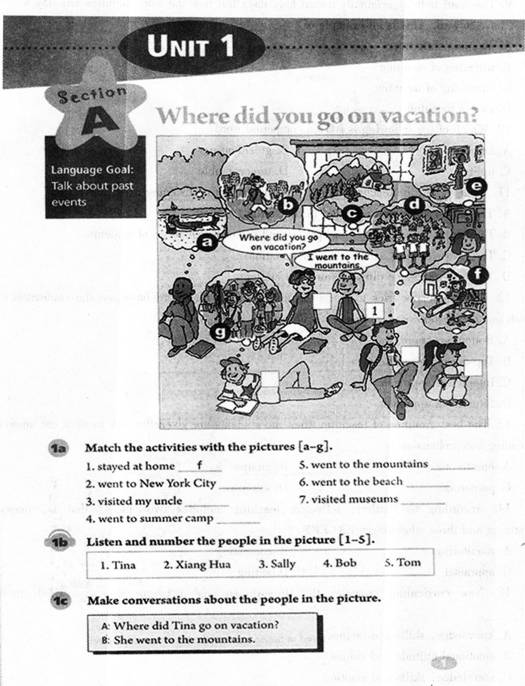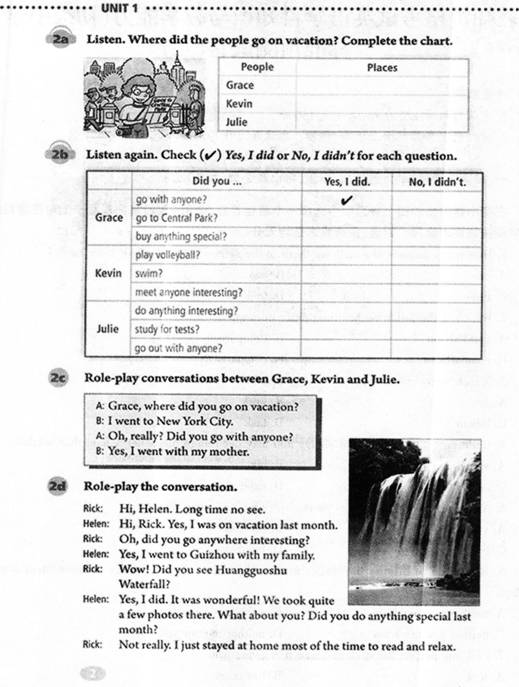根据提供的信息和语言素材设计教学方案,用英文作答。
33.设计任务:请阅读下面学生信息和语言素材,设计一节英语听说课的教学方案。教案没有固定格式,但须包含下列要点:
·teaching objectives
· teaching contents
· key and difficult points
· major steps and time allocation
· activities and justifications
教学时间:45分钟
学生概况:某城镇普通中学九年级(初中三年级)学生,班级人数40人,多数已经达到《义务教育英语课程标准(2011版)》四级水平,学生课堂参与积极性一般。
语言素材:


正确答案及解析
正确答案
解析
Teaching Content: This lesson contains some new words, phrases, and sentence patterns ot going on vacation. It will help students to express their past events.
?Teaching Objectives ..
?(1) Knowledge objective
?Students could learn some new phrases and sentence patterns of vacation.
?(2) Ability objective
?Students could talk about their activities during vacation.
?(3) Emotional objective
?Students could enhance friendship during the class by talking about common interests.
?Teaching Key Point:
?New phrases and sentence patterns about vacation
?Teaching Difficult Points:
?How to get the students to talk about the topic actively.
Teaching Aids :
?Multimedia, word cards, some related pictures
Teaching Procedures :
Step 1 Leading in and Warming up (5 minutes)
Greet with students and the teacher will share his / her own story about his / her vacation.
?(Justifications: It can attract students' interests to learn this lesson.)
Step 2 Pre-reading (10 minutes)
The teacher will play a video of travelling during vacation. Students review some phrases about going on vacation. Teacher asks "What did you do on your vacation? " to enlighten students on talking about their experience.
?(Justifications: Playing a video can lead in new class. The form of brainstorming is conducive to students'statements. It also paves the next step.)
Step 3 Phrases study (10 minutes)
Activity 1 : Make use of pictures on Page 1 to predict learning content and learn phrases"went to the beach""visited the museumsstayed at home", etc.
Activity 2: Students should do exercise in the textbook (la, lb).
Activity 3 : Students will do some added exercise of vocabulary by listening to the tape.
?(Justifications: Students will understand the meanings of new vocabulary and pictures. Exercise from la helps students memorize new content. Listening exercise from lb will recall the key phases to students.)
Step 4 Practice (5 minutes)
Activity 1 : Students will look at pictures on Page 2 and answer two questions.
Activity 2: Students should complete listening exercise from 2a and 2b.
(Justifications: Pictures help students understand listening content better. Exercise from 2a and 2b helps students know what it talks about.)
Step 5 Pair work (10 minutes)
Three students will work in a group and play conversation practice by imitating Grace, Kevin and Julie according to materials of 2a and 2b.
(Justifications: This part helps students consolidate new words and sentence patterns and imitate pronunciation of listening material.)
?Step 6 Summary and Homework (5 minutes)
?Summary: Students will recall what they have learned today. The teacher can repeat them.
?Homework: Students will prepare a speech on the topic "The most unforgettable thing during my vacation" after class and speak it out on the next class.
?(Justification: They can help students to consolidate the knowledge what they have learned on the class.)
?Blackboard Design :
New sentence patterns:
Where did Tina go on vacation?
She went to the mountains.
New phrases :
went to the beach
visited the museums
staved at home
你可能感兴趣的试题
教师职业道德区别于其他职业道德的显著标志就是( )。
-
- A.为人师表
- B.清正廉洁
- C.敬业爱业
- D.团结协作
- 查看答案
在教育史上主张“不愤不启,不悱不发”的教育家是()。
-
- A.孔子
- B.孟子
- C.荀子
- D.韩非子
- 查看答案
心理学家所说的“危险期”或“心理断乳期”是指( )。
-
- A.童年期
- B.少年期
- C.青年期
- D.成年期
- 查看答案
教育工作中做到“因材施教”、“长善救失”符合年轻一代身心发展的( )。
-
- A.顺序性
- B.个别差异性
- C.不平衡性
- D.互补性
- 查看答案
德育过程与品德形成过程的关系是( )。
-
- A.是一致的,可以等同
- B.教育与发展的关系
- C.相互促进的关系
- D.相互包容的关系
- 查看答案